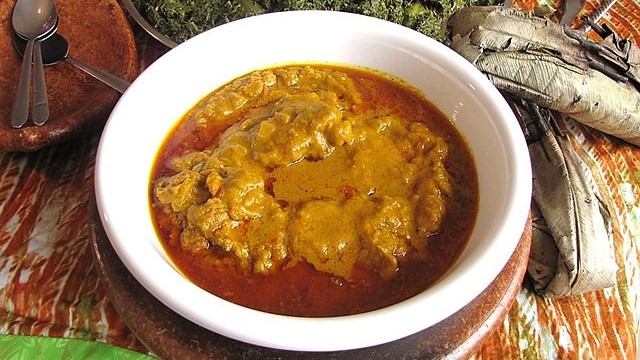By Jonas Loubin
In the humid warmth of Angola’s coastal markets, the air is heavy with the scent of ripe tomatoes, ground spices, and the nutty aroma of roasted peanuts. At the heart of this sensory tapestry stands a dish beloved across the country—Moamba de Galinha, a slow-cooked chicken stew as layered and enduring as the nation’s history itself.
Anchored in the rhythms of communal cooking and the traditions passed from kitchen to kitchen, Moamba de Galinha is a dish of substance and ceremony. It is often ladled into deep bowls during weddings, holidays, and Sunday gatherings, where conversation lingers as long as the stew simmers.
A Dish with Deep Roots
The name “Moamba” traces back to Kimbundu, one of Angola’s indigenous languages, carrying with it a sense of comfort and conviviality. This stew is no modern reinvention—it is a fixture of Angolan kitchens, its method and flavor profile preserved over generations.
The recipe begins with chicken, cut into portions and browned in vivid orange palm oil, an ingredient whose distinctive hue and richness are essential to the dish’s identity. Tomatoes and onions form the aromatic base, softened slowly until their sweetness deepens. Ground peanuts—or, in some kitchens, a smooth peanut paste—are stirred in, adding both body and a subtle, earthy note. Garlic, ginger, and the occasional chili complete the flavor’s architecture, balancing warmth and spice.
Simmered gently, the chicken absorbs the sauce’s complexity until it yields easily from the bone. Time is the quiet architect here, transforming everyday ingredients into something celebratory.
The Companions to Moamba
Rarely served alone, Moamba de Galinha finds its match in funge, a smooth, elastic accompaniment made from cassava or corn flour. Its neutral taste makes it an ideal foil for the stew’s intensity. Rice is another frequent partner, favored for its simplicity and ability to soak up the sauce.
More Than a Meal
In Angola, Moamba de Galinha is as much a cultural emblem as a culinary one. Preparing it is often a shared act, part of the choreography of family life. It carries the flavors of history—colonial encounters, indigenous techniques, and agricultural traditions—onto a single plate. For many Angolans abroad, the dish serves as a tangible link to home, its aroma stirring memories of open kitchens and crowded dining rooms.
Enduring Appeal
Moamba de Galinha’s richness lies not just in its ingredients but in its role as a vessel for connection. In every serving, there is continuity—between generations, between regions, and between past and present. For a country whose cuisine tells stories in spices and textures, it remains an enduring signature.
Sources:


